.jpg) BUY IT AT AMAZON: CLICK HERE!
BUY IT AT AMAZON: CLICK HERE!
STUDIO:
MSRP: $14.98
RATED: R
RUNNING TIME: 85 Minutes
SPECIAL FEATURES:
• Commentary by Cheech Marin and Director Lou Adler
• Roach Clips (Deleted Scenes) with Optional Commentary
• Lighting Up: A Look Back at Up In Smoke
• “Earache My Eye” Featuring Alice Bowie: Animated Music Video
• Cheech & Chong’s “The Man Song”
• 2 Vintage Radio Spots
• Theatrical Trailer
The Pitch
See Cheech and Chong’s first cinematic foray which has had a lasting impact on American comedy, like it or not.
The Humans
Cheech Marin, Tommy Chong, Stacy Keach, Tom Skerritt, Edie Adams, Strother Martin
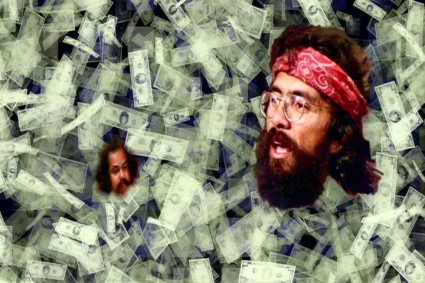
The shitty animation in question.
The Nutshell
Pedro (Marin) and ‘Man’ (Chong) couldn’t come from more different backgrounds, but car trouble and some well-placed padding places them together for a long and winding journey. What happens from there involves deportation, the smuggling of a van made entirely of marijuana across the border without being caught by the inept Sgt. Stedenko (Keach), competing in the battle of the bands in order to get a record deal, and most importantly of all: the quest for a lid.
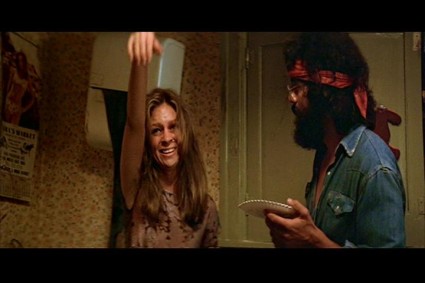
Chong knew he was in trouble when she revealed herself to be a member of the Gaystapo.
The Lowdown
I’ve always avoided seeing the Cheech and Chong movies – the ‘stoner’ film doesn’t appeal to me, I prefer my movies to be funny without the ingestion of hallucinogenics being a necessity (especially considering one of the film’s taglines was ‘Don’t see this straight’ – not a ringing endorsement). Finally seeing Up In Smoke for the first time didn’t prove me wrong – the movie isn’t particularly well-made and there’s a general dearth of comedy throughout the running time – but I didn’t find myself regretting the viewing experience afterwards.
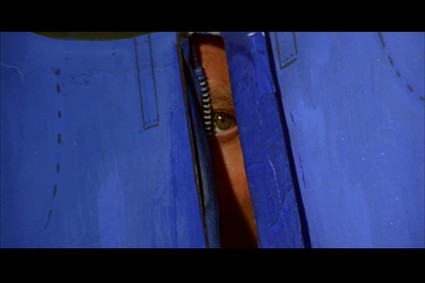
The end reveal of What Lies Beneath continues to shock to this very day.
Moreso than the character work, I think the shoddy filmmaking on display here works against the comedy as the camerawork is merely adequate and sometimes less than that in terms of framing the characters in their surroundings and delivering visual punchlines. Many scenes could’ve benefited from some studious editing on the filmmaker’s part as jokes drag on past their expiration date and some bits are telegraphed from a mile away. However much the low-fi and piecemeal approach to the filmmaking harms it in terms of comedic consistency, it actually feeds into the counter-culture/anti-authority vibe that the whole picture is trying to strike for its audience. The entire thing feels dangerous, kind of teetering on the precipice of pure anarchy at points – and there’s something seductive about that quality when I was watching it. And although the comedic pacing of numerous scenes is completely fucked (some jokes last forever, some seem completely lost at sea in terms of camera placement and line deliveries, some never seem to resolve themselves) it does allow for some jokes to slip in and out quickly in a way that one doesn’t see in film very often– my favorite of these is Chong’s reaction to the line "We’ve gotta find a way to get you out of here" immediately after he just managed his way back inside a house being busted by the cops. The punk rock battle of the bands that makes for the film’s conclusion is the perfect setting for the film’s rough-around-the-edges aesthetic (and serves as a great bookend to the aesthetically important opening on a TV screen showing old cartoons – this is probably as good as any indicator of the film’s broad comedic aspirations) and is the perfect melding of material and subject matter. Unfortunately it comes after about eighty minutes of uninspired comedy whose valleys vastly outnumber the peaks.
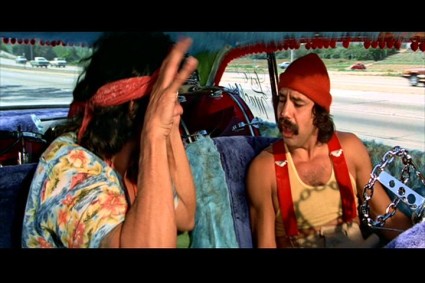
In order to avoid a dreaded X rating the filmmakers would have to remove the scene in which our heroes double team Hollow Man.
I don’t regret watching the movie, despite its many shortcomings – I think the movie has a cultural importance and is a piece of history in signifying the counter culture of that era (although I think this picture is also tweaking assumptions of that counter culture – if these two men are to be emblematic of it, it would seem to be a pretty aimless enterprise in the eyes of the filmmakers) with its strong anti-authoritarian vibe, and the success/flourishing of this film can’t be denied as a signifier of what people were looking for in their comedy/protagonists in that era. Also, the film clearly was a harbinger of things to come, and has had an obvious influence on films of its ilk that have come since then, so it’s also distinctive in terms of American film comedy history. However, culturally important does not equal good, and this film most certainly ain’t. Those who haven’t seen can feel free to continue their avoidance without any guilt or doubt in their minds.

Officer Johnson’s depth perception was severely lacking.
Any scene that involves just our two principles and nobody else is pretty grating in terms of comedy as you’re stuck with no straight man, just two broad comic generalizations going toe to toe. Of the two, Marin comes out better, as his character actually is able to get across some solid chunks of dialogue whereas Chong’s character is constantly behind the eight ball in sequences by design – leaving it kind of hard to find ways for him to deliver the comedic goods. It’s usually helpful for bit players to come in and break up the monotony of certain sequences like the Vietnam vet Strawberry played by Tom Skerritt or June Fairchild as a woman who snorts three lines of Ajax, so we’re not just left with our two main characters. One performance worthy of singling out is Stacy Keach as Sgt. Stedenko. His quest to bust the smuggling of the van made of marijuana across the Mexican-American border along with his group of fellow undercover officers makes for the majority of the best material in the movie. He’s clearly the most polished actor in the entire film and manages to mine the most humor of his character and the situations he finds himself in: his repartee with his fellow officers is the most fine-tuned of all of the exchanges in the picture (The scene where Keach briefs them about the way marijuana is being smuggled across the border and Keach’s freak-out near the end of the picture both are highlights).
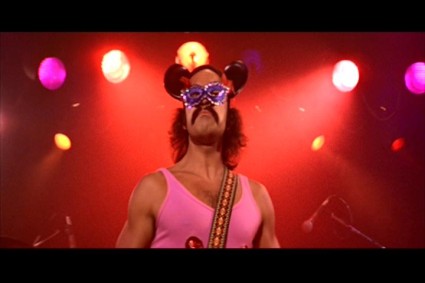
Disneyland Tijuana was a decidedly low-budget affair.
The Package
The cover art replicates the poster art and is pretty reasonable in setting ones expectations for the movie, honestly. The film looks alright, albeit grainy and the audio matches it in terms of being merely adequate instead of exceptional, but both of these contribute to the raw aesthetic of the film. There are a handful of special features for fans of the material to dig into here, but whoever Paramount had in charge of overseeing the extras for some of the features should be castrated. First up is an agreeable enough commentary track featuring Marin and director/producer Lou Adler; it’s clear that they’re still amused by many aspects of the film, and manage to get some worthwhile anecdotes in while laughing themselves silly. Also on board is a large handful of deleted scenes (‘Roach Clips’) with some optional commentary that are worth a spin just to see what they couldn’t use. There’s a nice ten+ minute retrospective with comments from Adler, Marin, and Chong that features some new information that doesn’t overlap with the commentary, so that’s appreciated. The next handful of features are where Paramount went bug-fuck crazy and decided to add their own animations to the features making them come across as lame attempts at ‘hip’ instead of just letting the features speak for themselves: that said, the animated music video is a good song and the radio spots are interesting in how they advertise for the movie. "The Man Song" is fluff, but showcases the amazing amount of "man’s" dropped throughout the picture’s running time. Also comes with the original theatrical trailer, which is fun to watch. Keep case.

The rare occurrence of frontal Manitou.
5.5 out of 10